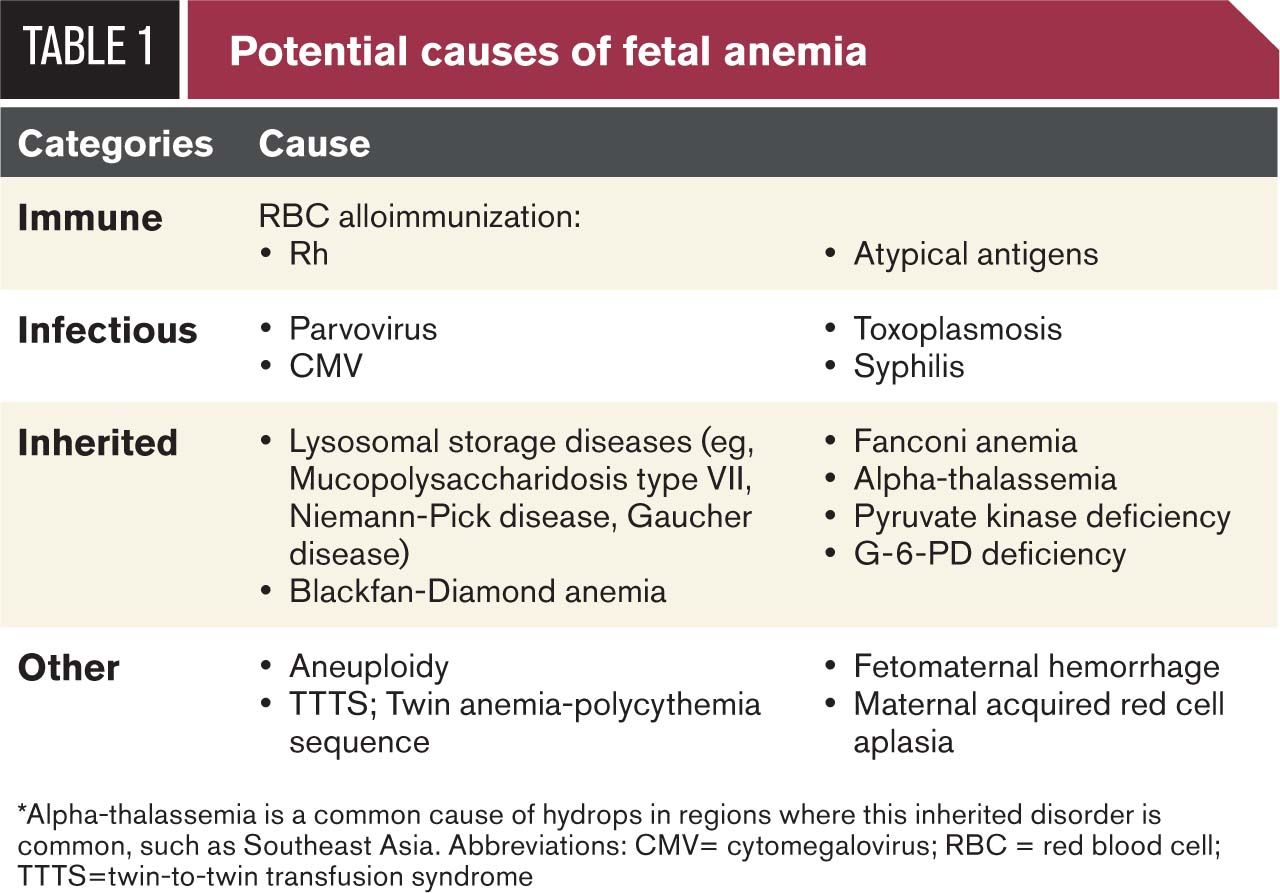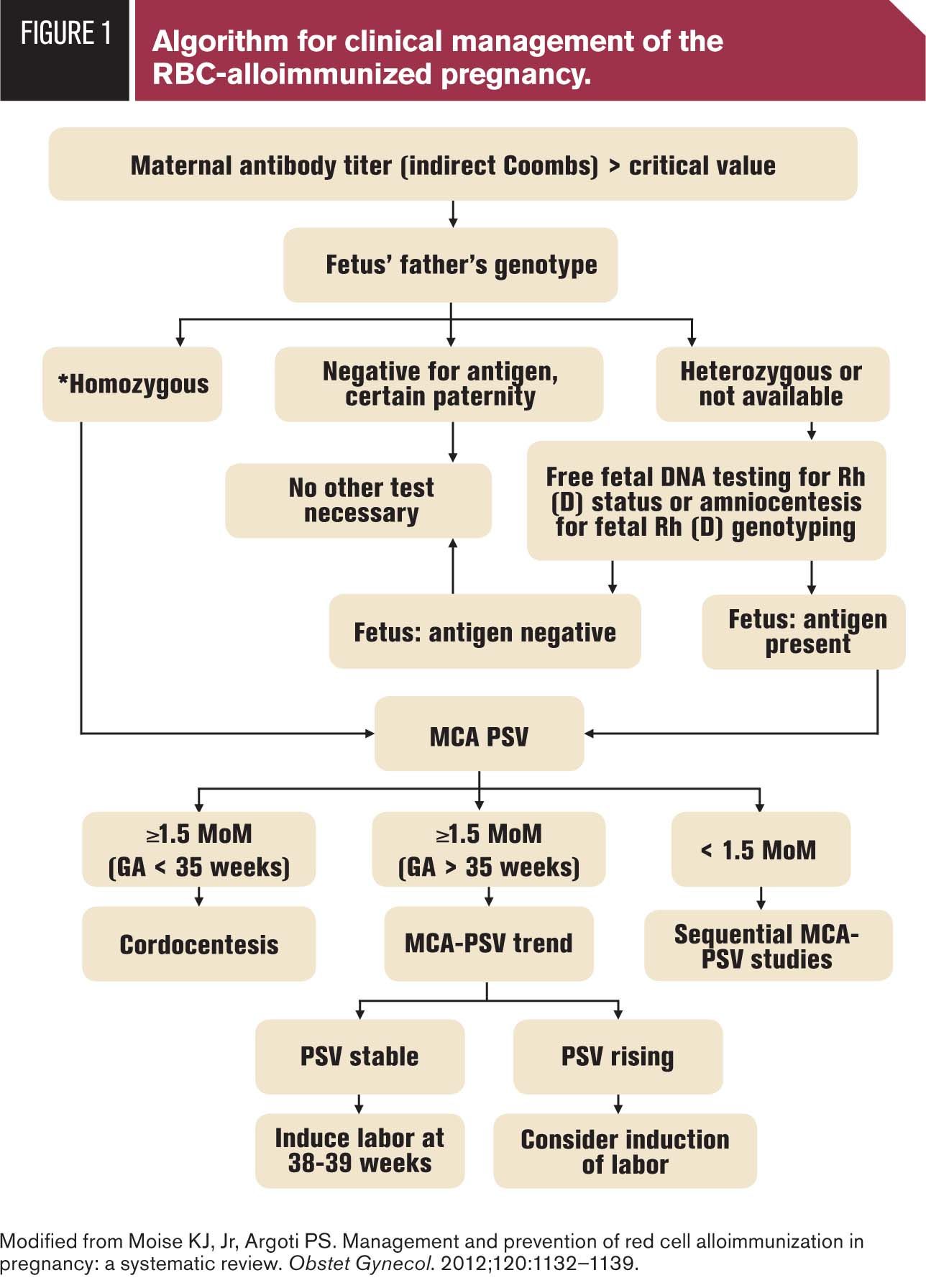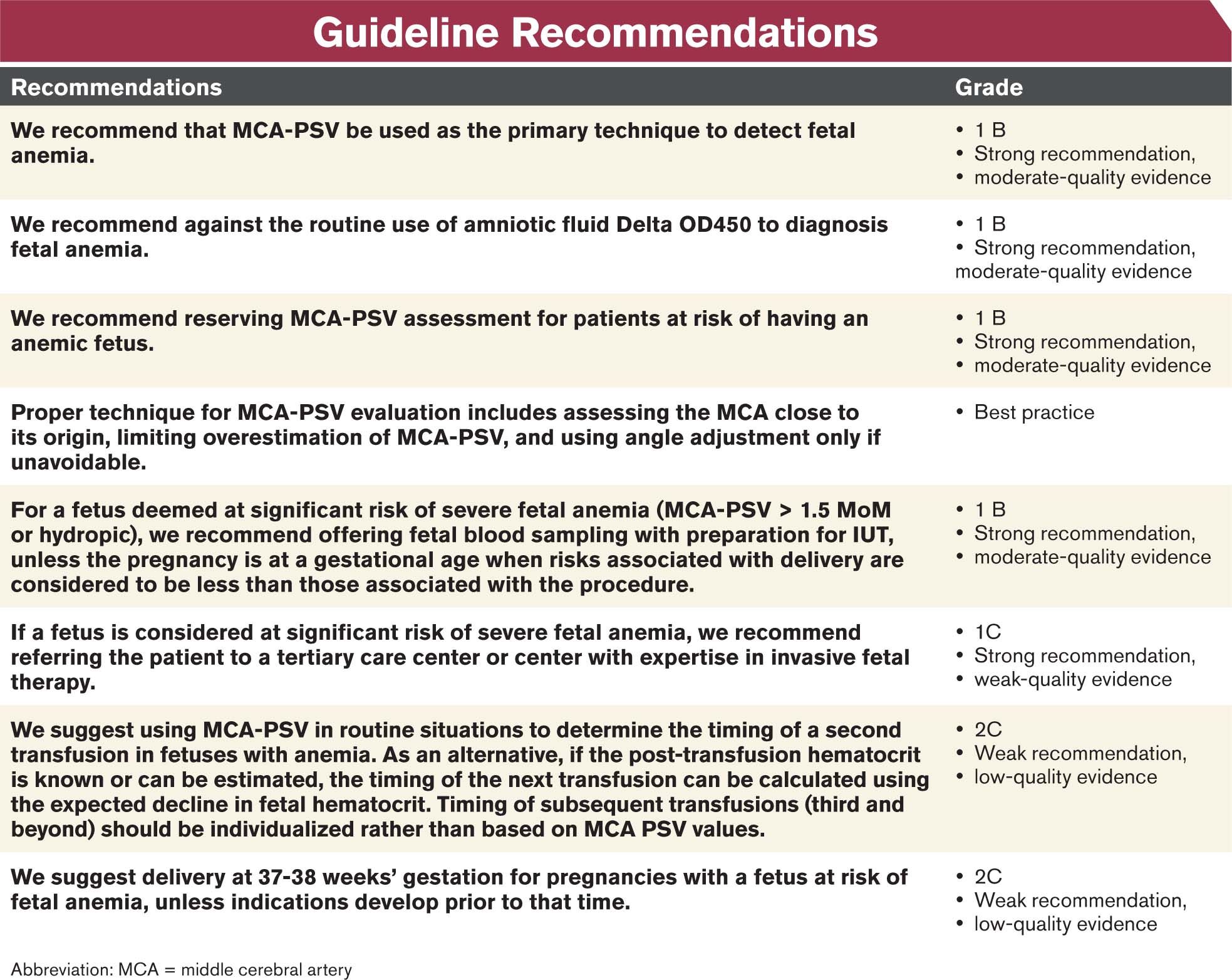SMFM Consult: The fetus at risk of anemia
A review of the causes, surveillance options, and management strategies for the pregnancy at risk of fetal anemia.
By the Society for Maternal-Fetal Medicine (SMFM), Giancarlo Mari, MD, Mary E. Norton, MD, Joanne Stone, MD, Vincenzo Berghella, MD, Anthony Sciscione, DO, Danielle Tate, MD, and Mauro Schenone, MD
Anemia continues to be an uncommon but life-threatening condition for the developing fetus. This summary reviews the causes, surveillance options, and management strategies for the pregnancy at risk of fetal anemia.
What is the definition of fetal anemia?
Fetal anemia can be defined using either hemoglobin or hematocrit values. A hemoglobin value that is more than 2 standard deviations below the mean is diagnostic of fetal anemia. Normally, fetal hemoglobin concentration increases with advancing gestation.
Severe anemia can lead to hydrops fetalis and fetal death. Hydrops related to anemia is rare in fetuses with hemoglobin concentrations greater than 5 g/dL, a value corresponding to 0.47 MoM at 18 weeks’ gestation and 0.36 MoM at 37 weeks’ gestation. Using a fetal hematocrit of less than 30% as a cut-off for fetal anemia appears equally reliable as using hemoglobin levels and is often used in routine clinical care.
What are the causes of fetal anemia?
Fetal anemia can result from many pathologic processes (Table 1). The most common causes in the United States are maternal alloimmunization and parvovirus infection. Maternal red blood cell (RBC) alloimmunization occurs when the immune system is sensitized to foreign erythrocyte surface antigens, stimulating the production of immunoglobulin G (IgG) antibodies. These IgG antibodies can cross the placenta and lead to hemolysis if the fetus is positive for the specific erythrocyte surface antigens.

The most common routes of maternal alloimmunization are blood transfusion or fetomaternal hemorrhage associated with delivery, trauma, spontaneous or induced abortion, ectopic pregnancy, and invasive obstetric procedures. Alloimunization resulting from use of Rh (D) immune globulin has greatly decreased the incidence of fetal anemia in North America. As a result, other alloantibodies have increased in relative importance, including those to other antigens of the Rh blood group system (c, C, e, E) and other atypical antibodies also known to cause severe fetal anemia, such as anti-Kell (K, k), anti-Duffy (Fya), and anti-Kidd (Jka, Jkb).
Parvovirus is the most commonly reported infectious cause of fetal anemia. In the fetus, the virus has a predilection for erythroid progenitor cells, leading to inhibition of erythropoiesis and resultant anemia. The risk of a poor outcome for the fetus is greatest when the congenital infection occurs before 20 weeks’ gestation. The risk of fetal death has been reported to be 15% at 13–20 weeks’ gestation, and 6% after 20 weeks. In most cases, the anemia is transient, but in severe cases, fetal intravascular transfusion may be needed to support the fetus through this aplastic crisis.
What is the appropriate management for a patient at risk of fetal anemia?
In women with RBC alloimmunization, parental assessment and testing are key initial steps in order to determine the potential fetal antigen status (Figure 1). This can be done through parental zygosity testing, direct genotyping of the fetus with amniocentesis, or noninvasive fetal genotyping from maternal blood using cell-free DNA.
In women who are at risk of fetal anemia due to parvovirus exposure, maternal antibody status (ie, immunoglobulin M [IgM]-positive status or IgG seroconversion) is useful to determine prior exposure and the presence of immunity. Although the peak risk for hydrops is 4 to 6 weeks after maternal infection, weekly evaluation of MCA Doppler studies and ultrasound finding of fetal hydrops are often continued for up to 10–12 weeks after exposure.

How is the diagnosis of fetal anemia made?
Fetal anemia can be directly diagnosed by fetal blood sampling in fetuses with hydrops or in cases that have surpassed the critical threshold for middle cerebral artery (MCA) Doppler values and are thereby at significant risk. These procedures carry potential risk to the fetus and mother of infection, preterm premature rupture of membranes, abruption, premature labor, fetal or maternal bleeding, worsening alloimmunization, and fetal death. Although the risk of fetal loss due to fetal blood sampling is reported to be 1%–2%, it is dependent on gestational age, with earlier gestations at higher risk.
Independent of etiology, fetal anemia can be detected by Doppler ultrasonography on the basis of an increase in the peak velocity of systolic blood flow (PSV) in the MCA. When a fetus is not anemic or is only mildly anemic, there is no strong correlation between MCA-PSV and fetal hemoglobin concentration, but as the he moglobin decreases, the MCA-PSV increases and can be used to determine the hemoglobin value with a good level of approximation.
A MCA-PSV of >1.5 MoM by Doppler is the cutoff commonly used to identify the severely anemic fetus. MCA-PSV has a sensitivity of 75.5% and a specificity of 90.8% for detecting severe anemia. Use of MCA-PSV trends (as opposed to a single measurement) may decrease the false-positive rate to less than 5%.
Originally developed to screen for fetal anemia caused by RBC alloimmunization, MCA-PSV has been demonstrated to be useful in the assessment of fetal anemia due to other causes, such as parvovirus, twin-twin transfusion syndrome, and fetomaternal hemorrhage.
Patient Handout: To download a patient education handout on fetal anemia, go to www.ContemporaryOBGYN.net/fetal-anemia.pdf
How should fetal anemia be managed?
If a fetus is deemed at significant risk for severe anemia based on MCA Doppler, fetal blood sampling should be offered after counseling the parents. It is important to have a coordinated team effort among individuals familiar with fetal blood sampling and intrauterine fetal transfusion. Referral to a center with expertise in invasive fetal therapy is recommended.
The fetal hematocrit at sampling, the fetal condition (eg, presence of hydrops), and the gestational age affect the optimal volume of blood to be given. In general, the final target hematocrit should be approximately 40%–50%. Transfusion to higher levels may allow a longer interval between transfusions, but higher blood viscosity at supraphysiologic hematocrit levels has been associated with a theoretical increased risk of complications. If the fetal hematocrit is >30%, no transfusion is necessary, although re-sampling may be recommended within 1–2 weeks, depending on the clinical circumstances.
Blood for intrauterine transfusions undergoes the same testing that occurs for any RBC donor unit, in addition to specific testing and preparation. For intrauterine transfusions, type O Rh (D)-negative blood is most often transfused; blood negative to other antigens, such as Kell, may be necessary at times. The units are screened to ensure they are cytomegalovirus-negative, and relatively fresh units are used to ensure optimal levels of 2, 3-dephosphoglycerate. Blood is irradiated to minimize risk of graft versus host reaction, and leukodepletion is also employed. Tightly packed donor cells (hematocrit of 75%–85%) are typically used to minimize the total required volume.
Once an intrauterine transfusion has been performed, a second transfusion is often necessary, especially if the fetus is remote from term. The need for serial or subsequent transfusions is typically lower in cases of parvovirus infection compared to alloimmunization.

What is the appropriate timing of delivery for a fetus at risk of anemia?
Unfortunately, high-quality data are lacking regarding the optimal timing of delivery in the fetus at risk of anemia, or in the fetus receiving in utero therapy due to anemia.
Expert opinion suggests planning delivery at 37–38 weeks’ gestation based on balancing the risk of stillbirth, the consequences of fetal anemia, and the risks of another fetal blood sampling procedure/intrauterine transfusion against the risks of prematurity and the additional morbidity of anemia and hyperbilirubinemia prior to term delivery. Therefore, most clinicians will perform the last fetal blood sampling and transfusion no later than 34–35 weeks’ gestation.
The goal is to deliver a fetus with no or only mild to moderate anemia.
Reference
1. Society for Maternal-Fetal Medicine (SMFM), Mari G, Norton ME, Stone J, et al. SMFM Clinical guidelines No. 8: The Fetus at Risk for Anemia: Diagnosis and Management. Am J Obstet Gynecol. [In press.]
Patient Handout: To download a patient education handout on fetal anemia, go to www.ContemporaryOBGYN.net/fetal-anemia.pdf
S4E1: New RNA platform can predict pregnancy complications
February 11th 2022In this episode of Pap Talk, Contemporary OB/GYN® sat down with Maneesh Jain, CEO of Mirvie, and Michal Elovitz, MD, chief medical advisor at Mirvie, a new RNA platform that is able to predict pregnancy complications by revealing the biology of each pregnancy. They discussed recently published data regarding the platform's ability to predict preeclampsia and preterm birth.
Listen
